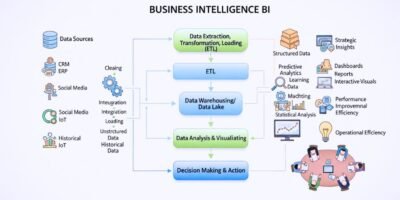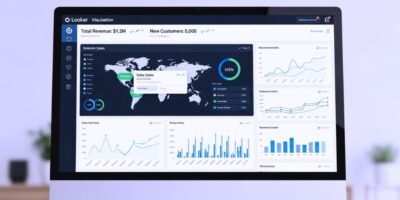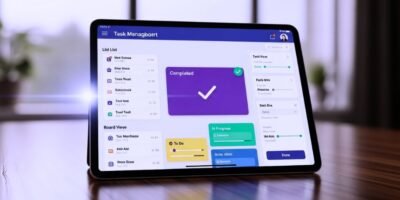In today’s competitive landscape, data is the most valuable currency. But raw data is just noise; the real power lies in transforming it into clear, strategic, and actionable insights. This is the core purpose of Business Intelligence (BI) software, which serves as the command center for the modern, data-driven organization.
As we look toward 2025, the best BI platforms are more than just reporting tools. They are intelligent, AI-infused ecosystems that empower everyone, from data scientists to business executives, to explore data, uncover trends, and make smarter decisions faster. Choosing the right software is a critical investment in your company’s future. Here are the top 5 BI market players leading the charge.
Microsoft Power BI
Microsoft has cemented its position as the market leader by creating a powerful, accessible, and deeply integrated BI platform. Power BI has become the default choice for millions of organizations already operating within the Microsoft ecosystem.
Its strength lies in combining a user-friendly interface for business analysts with the enterprise-grade scalability and governance of the Azure cloud.
- Unmatched Ecosystem Integration: Offers seamless, native connections to the entire Microsoft stack, including Azure, Microsoft 365 (Excel, Teams), and Dynamics 365, creating a unified data environment.
- Powerful AI and Self-Service Features: Tools like Q&A (ask questions in natural language) and integrations with Azure Machine Learning empower non-technical users to discover insights that were once the domain of data scientists.
- Market-Leading Value and Accessibility: Provides an incredibly robust set of features at a highly competitive price point, with a very capable free desktop version for individual users.
- Constant Innovation: Microsoft maintains an aggressive monthly update cycle, consistently rolling out new features and improvements that keep the platform on the cutting edge.
Best For: Enterprises committed to the Microsoft stack, SMBs looking for a cost-effective yet powerful solution, and teams that need to embed analytics into everyday applications.
Tableau (a Salesforce company)
Tableau is renowned for its best-in-class data visualization and exploration capabilities. It has long been the gold standard for creating beautiful, interactive, and insightful dashboards that make complex data easy to understand.
Since its acquisition by Salesforce, Tableau has deepened its integration with the world’s #1 CRM, making it an analytics powerhouse for sales and marketing teams.
- Superior Visual Analytics: Tableau excels at turning data into compelling visual stories. Its intuitive drag-and-drop interface is a favorite among data analysts for its flexibility and power.
- Strong Community and Ecosystem: Tableau Public is a massive online repository of visualizations and a vibrant community where users can learn, share, and find inspiration.
- Deep Salesforce Integration: The fusion with Salesforce Einstein AI brings predictive analytics and automated insights directly into dashboards, especially for customer and sales data.
- Flexible Data Connectivity: Connects to a vast array of data sources, from simple spreadsheets to complex cloud data warehouses like Snowflake and Redshift, whether on-premise or in the cloud.
Best For: Organizations with a strong focus on data storytelling, self-service analytics for business users, and companies looking to embed powerful analytics within their Salesforce environment.
Qlik Sense
Qlik has been a pioneer in the BI space and continues to differentiate itself with its unique and powerful Associative Engine. Unlike traditional query-based tools that show a filtered view of data, Qlik allows users to explore all data relationships freely.
This patented technology reveals not only the expected answers but also the unexpected insights hidden in your data, showing what is—and is not—related to your selections.
- The Associative Engine: This core technology allows for free-form, multidirectional data exploration, uncovering hidden connections that other tools might miss.
- Focus on Active Intelligence: Qlik is a leader in promoting “Active Intelligence,” the concept of using real-time, up-to-date data to trigger immediate actions and automate decision-making processes.
- Powerful AI and Cognitive Engine: Its Insight Advisor uses AI to generate charts automatically, suggest insights, and allow for natural language interaction with the data.
- End-to-End Data Pipeline: Offers a comprehensive suite of tools that extends beyond BI, including data integration and cataloging, creating a complete enterprise data solution.
Best For: Enterprises that need to perform complex data exploration on large datasets, and organizations looking to build a full data pipeline from integration to action.
Google (Looker & Looker Studio)
Google’s BI offering is a two-pronged powerhouse that serves both ends of the market. Looker Studio (formerly Google Data Studio) provides a free and easy-to-use tool for dashboarding. At the same time, the enterprise-grade Looker platform offers a robust semantic modeling layer for governed, scalable analytics.
Together, they leverage the immense power of the Google Cloud Platform, especially when paired with BigQuery, to deliver a comprehensive analytics solution.
- Looker’s Semantic Layer (LookML): The enterprise Looker platform’s greatest strength is LookML, a modeling language that allows data teams to define business logic and metrics centrally. This creates a reliable “single source of truth” for the entire organization.
- Seamless Google Ecosystem Integration: Looker Studio offers free, native connectors to Google products like Google Analytics, Google Ads, and BigQuery, making it the default choice for marketing and web analytics.
- Cloud-Native and Highly Scalable: Built on and for the cloud, the entire Google stack is designed for massive scalability and performance.
- Embedded and API-First: Looker is designed to be embedded into other applications, allowing companies to bring data directly into their own products and workflows.
Best For: Marketing teams and SMBs (Looker Studio), and data-driven enterprises that need a governed, scalable, and embeddable data platform (Looker).
ThoughtSpot
ThoughtSpot is a leader in the next generation of BI, built around a search- and AI-driven analytics experience. Its core philosophy is to empower any business user, regardless of technical skill, to get answers from their data as easily as using a search engine.
This consumer-grade user experience is rapidly gaining traction in enterprises seeking to democratize data access and foster a genuine data culture.
- True Search-Based Analytics: The primary interface is a search bar. Users can type questions in natural language (e.g., “show me last quarter’s sales by region”) and get an interactive chart or answer instantly.
- AI-Powered Insights (SpotIQ): ThoughtSpot’s AI engine automatically analyzes data to find anomalies, trends, and correlations that a human analyst might not think to look for.
- Direct Cloud Data Warehouse Connectivity: Uses a “live query” architecture to connect directly to cloud data warehouses like Snowflake, Databricks, and BigQuery, leveraging their power and scalability without moving data.
- Focus on Actionable Insights: The platform is designed to provide not just charts, but clear, actionable insights that can be embedded directly into business applications.
Best For: Large enterprises focused on fostering a self-service data culture, and organizations wanting to empower non-technical business users to answer their own data questions instantly.
Conclusion
The Business Intelligence market in 2025 is a vibrant arena where AI-driven insights and self-service analytics reign supreme. While Microsoft Power BI and Tableau continue to lead in broad adoption, the landscape is rich with powerful specialists. Qlik offers unparalleled data exploration, Google’s Looker provides enterprise-grade governance, and ThoughtSpot is paving the way for a search-first future.
The best choice for your organization will depend on your existing technology stack, the data literacy of your users, and your strategic goals. However, any one of these five leaders can provide the tools needed to transform your data from a static resource into your most dynamic strategic asset.













